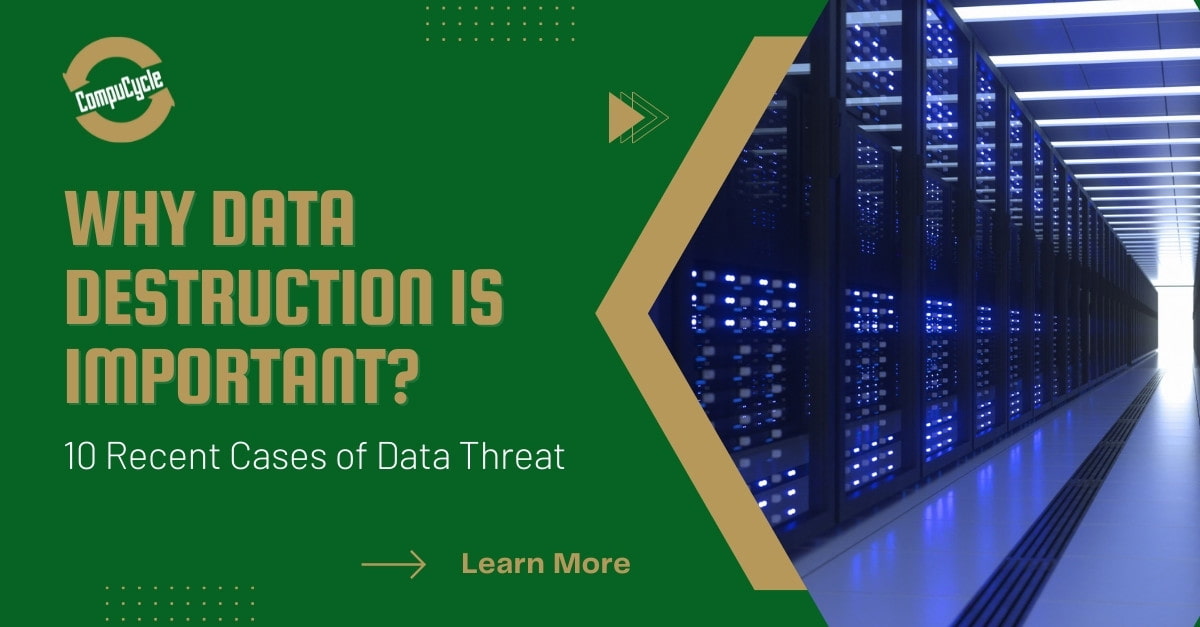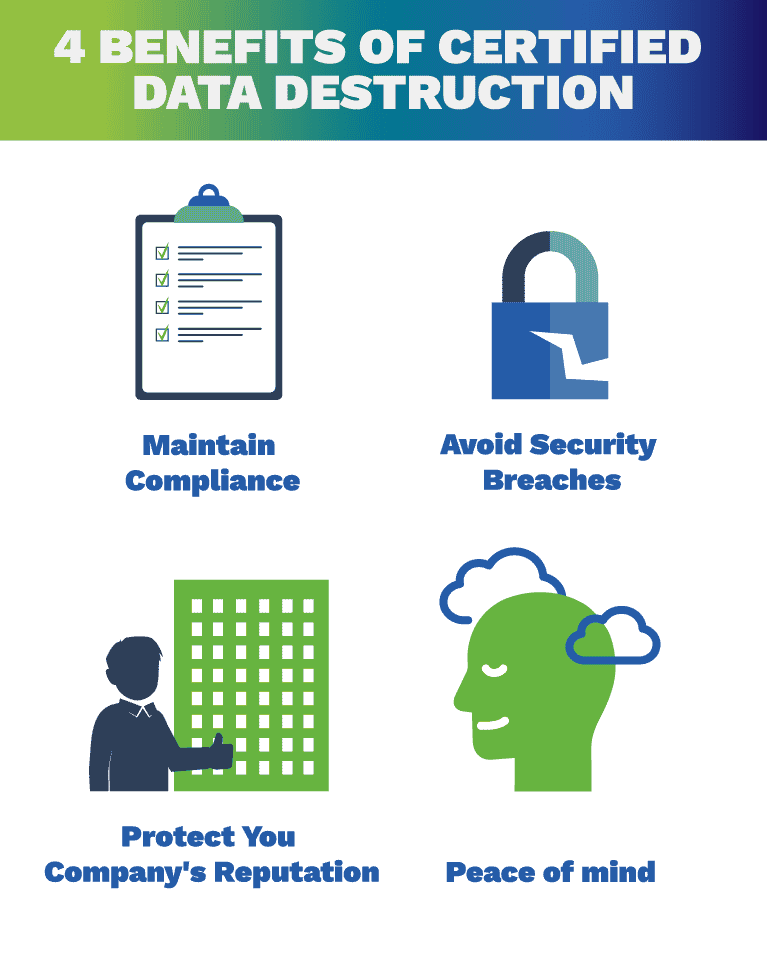The Influence of Effective Data Destruction on Cyber Security Danger Management
The Influence of Effective Data Destruction on Cyber Security Danger Management
Blog Article
Discovering the Importance of Information Devastation in the Context of Computer Safety Solutions and Protecting Confidential Data
In an age where data breaches are progressively common, the significance of efficient information destruction can not be overemphasized. When no much longer required, Organizations must take on stringent actions to ensure that sensitive info is not just shielded throughout its lifecycle however likewise emphatically eliminated. The approaches used for data obliteration, paired with compliance to legal standards, play a critical function in keeping discretion and trust fund. However, the effects of these methods expand past plain compliance, influencing a company's online reputation and functional honesty in the digital market. What techniques can organizations execute to boost their data damage methods?
Recognizing Information Damage
Data damage is a critical element of computer safety that entails the permanent elimination of information from storage space tools to avoid unauthorized gain access to and prospective information breaches. In a progressively electronic landscape, companies encounter enhanced threats related to delicate details being improperly accessed or exploited. Effective information destruction safeguards against these threats, making certain that personal dataâEUR" such as client details, copyright, and economic recordsâEUR" can not be recuperated after disposal.
Recognizing the importance of information destruction expands past plain compliance with legal and regulative structures; it is vital for preserving organizational stability and count on. When information is incorrectly managed or inadequately destroyed, the effects can be extreme, consisting of economic loss, reputational damage, and lawful responsibilities.

Approaches of Information Elimination

One widespread method is data cleaning, which involves overwriting existing information with arbitrary patterns numerous times. This method provides the original information irretrievable, making it a popular selection for companies looking for to protect personal details.
An additional approach is degaussing, which uses an effective electromagnetic field to interfere with the magnetic domain names on storage tools, efficiently removing the data. This method is especially reliable for magnetic media but is not appropriate to solid-state drives.
Physical damage is another robust technique, crushing or entailing the shredding of storage tools. This technique guarantees that data recuperation is practically impossible, making it optimal for highly sensitive information.
Finally, encryption can serve as a corresponding method to information obliteration. By securing information before removal, organizations can add an added layer of safety, making sure that even if residues are recovered, they continue to be unattainable without the decryption secret. Each method should be chosen based upon the degree of data level of sensitivity and the details safety requirements of the company.
Legal Compliance and Information Safety And Security
Organizations need to browse a complicated landscape of lawful needs connected to information security, especially after executing methods of data eradication. Various guidelines, such as the General Data Defense Policy (GDPR) and the Medical Insurance Portability and Responsibility Act (HIPAA), enforce stringent standards on just how companies must take care of and get rid of of delicate information. Failing to comply with these regulations can result in considerable legal effects, consisting of significant fines and reputational damage.
Data devastation processes need to be diligently recorded to show compliance with suitable regulations and criteria. This documentation not just offers as evidence of adherence click to legal commitments but additionally illustrates a dedication to securing sensitive information. Organizations needs to likewise establish clear policies relating to data retention and damage timelines, making sure that information is not held longer than necessary.

Moreover, normal audits and analyses of information destruction techniques are important to keep compliance and adjust to advancing legal frameworks (data destruction). By proactively attending to legal needs, organizations can mitigate dangers related to data violations and demonstrate their commitment to information safety and security. Ultimately, prioritizing legal conformity in data devastation processes is not simply a regulatory responsibility, however an essential element of a robust data security approach
Effect On Organization Reputation
The reputation of an organization can be considerably affected by its technique to information devastation and administration. In today's digital landscape, where information breaches can occur at any kind of minute, the failing to effectively throw away delicate information can bring about extreme consequences. Organizations that improperly manage information damage threat revealing personal client details, which not just violates privacy regulations but likewise erodes count on among stakeholders and clients.
A tarnished track record can result in lowered consumer commitment, as clients become reluctant to involve with an organization that has demonstrated oversight in shielding their data. Additionally, adverse attention bordering a data violation can have a long-term result, as possible customers could be prevented by the perceived absence of protection. This can bring about a direct decline in income and market share.
Furthermore, services that focus on information damage as component of their safety and security approach can boost their reputation by showcasing their commitment to securing delicate info. By embracing rigorous information monitoring techniques, companies can not just minimize risks yet additionally position themselves as trustworthy entities in their respective sectors, consequently reinforcing their general brand name image.

Best Practices for Secure Disposal
Executing finest practices for safe and secure disposal of data is crucial for reducing threats connected with data breaches and ensuring compliance with personal privacy laws. Organizations needs to embrace an extensive information disposal policy that read the full info here outlines procedures for both electronic and physical data destruction.
For physical information storage tools, such as hard disk drives, shredding or degaussing is recommended to protect against data healing. Furthermore, companies must preserve a chain of protection documentation throughout the disposal procedure, making certain responsibility and traceability of disposed products.
For electronic data, utilizing software application that sticks to market criteria for information wiping is vital. This software application should overwrite existing data numerous times, making healing essentially impossible. It is also crucial to confirm the effectiveness of the information damage procedure through audits or third-party evaluations.
Educating workers on protected disposal techniques adds one more layer of security, as human mistake can usually cause information exposure. Regularly upgrading and evaluating disposal policies makes certain alignment with developing guidelines and technical improvements. By executing these ideal practices, companies can considerably decrease the risk of unapproved information gain access to and improve their total information defense technique.
Conclusion
In final thought, information damage is a basic facet of computer safety services that ensures the defense of private details from unauthorized gain access to. Applying reliable techniques of information eradication, sticking to lawful conformity, and acknowledging the influence on company track record are necessary i loved this components of an extensive data security technique. By embracing best practices for safe disposal, companies can foster trust fund with customers and guard sensitive data, ultimately contributing to a more secure electronic landscape.
In a period where data violations are significantly usual, the relevance of effective information devastation can not be overstated.Information damage is a critical component of computer safety and security that includes the long-term removal of data from storage space gadgets to protect against unauthorized access and prospective data breaches. Organizations must also establish clear policies pertaining to data retention and destruction timelines, making sure that data is not held longer than required.
By proactively attending to legal needs, organizations can minimize dangers connected with information violations and demonstrate their dedication to information security (data destruction). Inevitably, prioritizing lawful conformity in information destruction procedures is not simply a regulative responsibility, yet an essential facet of a robust information security technique
Report this page